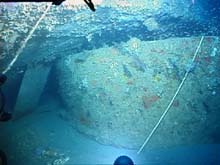
The Monitor's inverted hull lies atop her displaced turret. Note the plate hanging down to the left of the 9-ft-high, 22-ft-diameter turret. (Monitor Collection, NOAA) Click image for larger view.

The Monitor's 9-ft propeller and 11 ft of propeller shaft were recovered in June 1998. The propeller was removed from the wreck to help relieve stresses at the stern, and to preserve one of the few existing original John Ericsson screw propellers. Ericsson was the Monitor's designer and an engineering visionary of his time. (Jeff Johnston, Monitor Collection, NOAA) Click image for larger view.
The Wreck of the USS Monitor
Condition of the Wreck
The deterioration of the Monitor’s hull is significant. None of the lower hull forward of the midships bulkhead remains standing. The only relatively intact portion of the lower hull is the area over the galley and the engineering spaces aft of (behind) the midships bulkhead. All of the associated framing and side plating on the portside lower hull is missing, exposing the engine room and port coal bunker. The port deck support stanchions are mostly bent or collapsed.
The majority of the side plating on the starboard side of the lower hull is also missing, but most of the side frames and deck support stanchions remain. The loss of plating on the starboard side allows the prevailing current to pass through the wreck. The wooden deck beneath the original location of the turret has disintegrated, leaving a gaping hole approximately 21 feet in diameter through the deck. Machinery and other material has spilled out onto the seabed.Continuing Deterioration
The hull has deteriorated to an alarming degree in recent years. Apparently, a major collapse of the aft lower hull occurred between 1987 and 1990, undoubtedly due to the weight of the boilers and machinery, which hung suspended from the inverted deck. The result was that the entire aft lower hull dropped several feet on the port side, bending or collapsing the remaining port deck support stanchions, until the weight of the machinery was taken up by the inverted deck and the underlying seabed. Also, probably during the same incident, the midships bulkhead partially collapsed, causing the turret support truss to separate from the bulkhead and cant to starboard.The armor belt, constructed of wood covered by layers of iron armor, is also showing increasing signs of disintegration. A wood sample cored from the armor belt over the turret in 1998 was surprisingly sound and showed no evidence of shipworm (teredo) damage. However, the stern end of the portside armor belt has deteriorated approximately 6 feet since the wreck was discovered in 1974, and approximately 24 feet of the stern has disintegrated since the vessel sank in 1862. Hull plating can be seen lying in the sand at the stern of the wreck.
Recent Changes
NOAA and NOAA-permitted expeditions have noted even more significant changes at the site in recent years. The process of deterioration has begun to accelerate, with the Monitor’s hull beginning to collapse like a house of cards. Most of these changes have occurred aft of the midships bulkhead. In 1990, an anchoring incident by a private fishing vessel damaged the wreck. The vessel’s anchor snagged the skeg -- the support for the rudder and propeller shaft -- pulling it to starboard. This ripped open the hull plating at thestern, exposing the aft area of the engine room. It cannot be determined if this incident triggered the collapse of the lower hull.
The inverted deck is also beginning to show evidence of deterioration. Sunlight can be seen beneath the wreck where openings in the deck allow light to shine through onto the seabed. Most of the openings are believed to result from displaced hatch covers; however, others are the result of continuing deterioration. Iron armor plating has separated from the deck in several places, especially in the stern. At least one plate hangs from a few remaining iron spikes in the deck, with the other end resting on the sand beneath. Once the plating is gone, the underlying wood is quickly destroyed by shipworms.
In April 2001, NOAA research divers discovered that the deck had begun to open and collapse where it comes into contact with the turret. Fortunately, the hull stabilization completed in 2000 should prevent a catastrophic collapse in the stern. The removal of the engine, planned for 2001, should relieve much of the stress that is contributing to the collapse of the hull around the turret.
Sign up for the Ocean Explorer E-mail Update List.






















